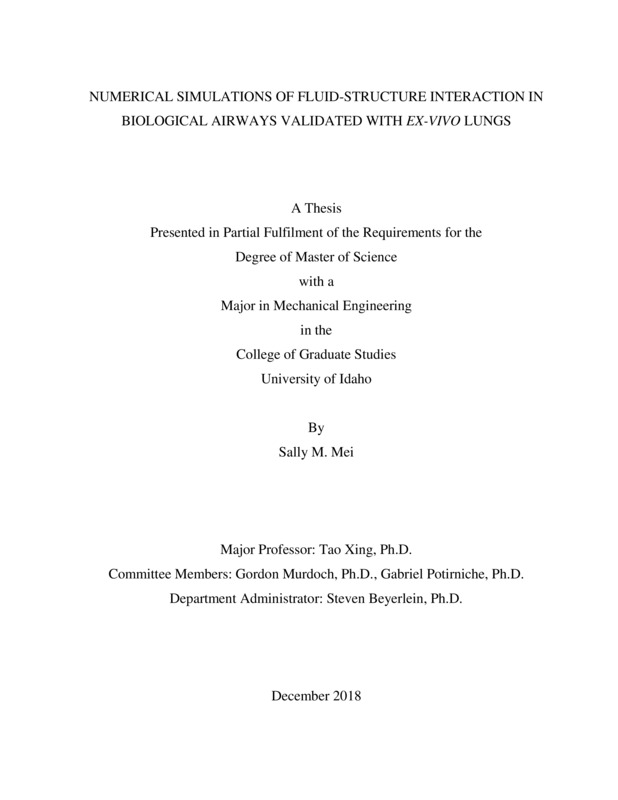NUMERICAL SIMULATIONS OF FLUID-STRUCTURE INTERACTION IN BIOLOGICAL AIRWAYS VALIDATED WITH EX-VIVO LUNGS
Mei, Sally. (2018-12). NUMERICAL SIMULATIONS OF FLUID-STRUCTURE INTERACTION IN BIOLOGICAL AIRWAYS VALIDATED WITH EX-VIVO LUNGS. Theses and Dissertations Collection, University of Idaho Library Digital Collections. https://www.lib.uidaho.edu/digital/etd/items/mei_idaho_0089n_11495.html
- Title:
- NUMERICAL SIMULATIONS OF FLUID-STRUCTURE INTERACTION IN BIOLOGICAL AIRWAYS VALIDATED WITH EX-VIVO LUNGS
- Author:
- Mei, Sally
- Date:
- 2018-12
- Embargo Remove Date:
- 2020-07-08
- Keywords:
- Balloon FSI Lung Ogden Model Tensile Testing Trachea
- Program:
- Mechanical Engineering
- Subject Category:
- Mechanical engineering
- Abstract:
-
Understanding fluid and structure interactions in biological airways is essential for explaining the physics of gas exchange that governs air flow in human and animal lungs. However, a limited number of studies are available due to the challenges of modeling and lack of experimental data. This study bridges the knowledge gap through Fluid-Structure Interaction (FSI) simulations combined with mechanical tissue testing. FSI is a coupling between two classic simulation methods: Computational Fluid Dynamics (CFD) and Finite Element Analysis (FEA). FSI is especially popular among researchers performing biomedical and biomechanical studies, due to the complex, dynamic geometries. In the case of human lungs, the geometry of respiratory tract is extremely complex. To accurately model the behavior of the lower respiratory tract, smaller portions of the respiratory system: the trachea and two generations of connecting bronchi (part of the upper airway) were specially chosen for this research. Couple case studies have been used to prove the validity of the human lung FSI simulation results. The case studies included a quasi-2D “square balloon” FSI simulation and a 3D balloon FSI simulation. In addition, tensile tests were conducted to obtain material properties of porcine tissue for the lung FSI simulation. Material properties were determined with curve fitting of porcine tissue in axial and circumferential directions to further enhance the accuracy of the human lung FSI model. Conclusions from each case study, experimental testing, and human lung FSI are provided and serve to advance the interdisciplinary study of respiration kinetics.
- Description:
- masters, M.S., Mechanical Engineering -- University of Idaho - College of Graduate Studies, 2018-12
- Major Professor:
- Xing, Tao
- Committee:
- Murdoch, Gordon; Potirniche, Gabriel
- Defense Date:
- 2018-12
- Identifier:
- Mei_idaho_0089N_11495
- Type:
- Text
- Format Original:
- Format:
- application/pdf
- Rights:
- In Copyright - Educational Use Permitted. For more information, please contact University of Idaho Library Special Collections and Archives Department at libspec@uidaho.edu.
- Standardized Rights:
- http://rightsstatements.org/vocab/InC-EDU/1.0/

